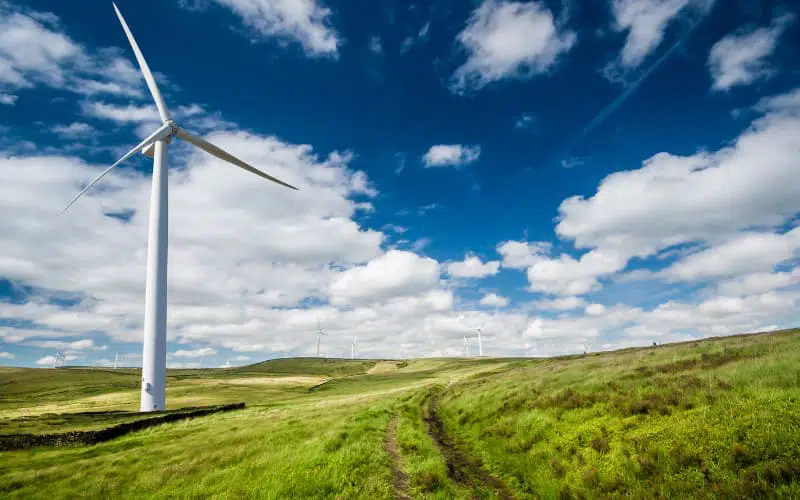
It is a part of the wind turbine that is made up of the blades, the hub and the blade pitch change mechanism . Its main characteristics and components are the following:
Commercial wind turbines being built today are horizontal main axis (also called HAWTs). The vertical axis presents some advantages over the horizontal ones, such as not needing a tower for its installation or an orientation mechanism to turn the rotor against the wind, but for a similar efficiency it presents many more disadvantages than the horizontal axis. Some of these disadvantages are: the wind speeds near the ground are lower, more difficult control since they do not allow varying the angle of the blades, among others.
The upstream machines have the windward rotor (facing the wind), avoiding with this type of current the shelter of the wind behind the tower. Most wind turbines have this design. The main disadvantage is that the rotor needs to be inflexible and located at some distance from the tower, so that the blades do not pass too close to it. On upstream machines the main axis is usually inclined 2 to 5 degrees.
Downstream machines have the rotor located on the lee side of the tower. The advantage is that they can be built without an orientation mechanism, since the nacelle (which is the cubicle in which the gearbox, the main shaft, the control systems, the generator, the brakes and the turning mechanisms are located) follow the wind passively. The blades have a small taper angle with respect to the axis of rotation; thus, when the wind direction varies, an uneven moment is produced in the blades that causes a torque on the rotor, orienting it. In downstream machines the rotor can be more flexible.
One to three blades can be used by gently turning. In the case of aerodynamic profiles with a low structural area and with low vortex generation, higher energy levels and a higher power coefficient are obtained.
Another possibility would be wood and metal constructions with a high number of blades, generally more than 6.
The most common nowadays are the three-bladed design with the windward rotor (facing the wind), with electric motors in their orientation mechanisms.
The outline of the blades should be hyperbolic. Manufacturers use aerodynamic profiles in their blades, introducing more and more improvements to reduce losses due to wake, vortexes and improve the efficiency of the profiles.
The blades are attached to the hub, which is responsible for transmitting all forces, moments and vibrations to the tower. The most normal thing is that this hub is rigid, especially in small and medium power machines.
You can also choose to use a swingarm hub in the design, thus smoothing operation and reducing loads on the blades.
The tower is the structure that supports the wind turbine’s electricity-producing mechanism at a certain height. By raising the components, a greater use of the force of the wind is achieved, since at a higher height above ground level, the greater its speed, and therefore, also the speed of rotation of the blades. Its design usually consists of a conical or hollow tubular steel trunk, in which the accessory floor equipment is housed and a safe access to the gondola is facilitated by means of a ladder.
It is the main chassis of the wind turbine, it is located in the upper part of the tower and inside are the electrical and mechanical elements necessary to convert the rotation of the rotor into electrical energy. It is connected to the tower by a toothed ring to allow the orientation of the rotor to the wind, and the rotor and the blades by the main shaft that will transmit the wind force to the multiplier and to the motor successively. On the outside it has an anemometer and a weather vane installed connected to the wind turbine control systems, and some vents to guarantee the cooling of the engine. They are constructed of forged steel and fiberglass plates.
It is an aerodynamic element that is located in front of the wind direction, protruding from the joint area between the blades and the hub. Its mission is to redirect the wind from the front part of the rotor to the nacelle vents and at the same time avoid turbulence in the front part of the rotor.
It is in charge of transmitting the energy produced by the rotation of the rotor to the motor in a way that can be used by it for the generation of electrical energy. It is made up of the main shaft, gearbox and secondary shaft. The main shaft is a large-diameter solid steel tubular piece, integrally attached to the rotor and rotating at speeds of between 22 and 64 rpm, depending on the wind turbine model and operating conditions. However, a standard electric generating motor requires rotational speeds of around 1500 rpm, which is why a multiplier is necessary to increase the transmitted rotational speed. The multiplier is a gearbox that converts the low spindle speed and high power of the main shaft into a suitable spindle speed for engine operation at the cost of power.
The generator converts the mechanical energy produced by the rotor into electrical energy. Asynchronous squirrel cage generators are often used, along with capacitor banks to improve their power factor. The connection to the grid can be direct or indirect to the grid, depending on whether the turbine works at constant or variable speed. By working indirectly connected to the grid, we are able to take advantage of the wind speed peaks, but the generator produces energy of variable frequency, so adaptation equipment is needed to feed the energy into the grid. In the direct form of connection, the grid itself limits the speed of rotation of the generator, so it does not take advantage of the higher energy peaks of the wind.
The control systems in a wind turbine have two important tasks, the first is the maximum use of the wind force through the orientation of the rotor, the second is the protection of the wind turbine against wind speeds that could damage the installation.
For the purpose of orientation, the wind turbine has anemometric and wind direction measurement equipment installed on the nacelle. The data collected is passed on to the control computer which, according to a certain algorithm, will decide how the nacelle should move thanks to the toothed ring system and turning motor installed at the base of the nacelle at its junction with the tower.
It is necessary to clarify that the control over the orientation of the rotor is not carried out in real time, but rather that the algorithm, with the data collected, must be able to guarantee that the wind has actually changed direction in a stable way, before it breaks. cause the nacelle to rotate, as otherwise it would lead to erratic movement of the system that would reduce its efficiency.

Hi, my name is Tony Overton. I'm a businessman and engineer with a corporate management background. I try my best to keep fit and healthy and to develop a good work / life balance where I can experience the best that life has to offer whilst pursuing my business focus to be the most successful that I can be. On this blog, you will find out how I am able to achieve the success and results and at the same time talk about lifestyle topics that I'm sure you'll enjoy.
Click to read on